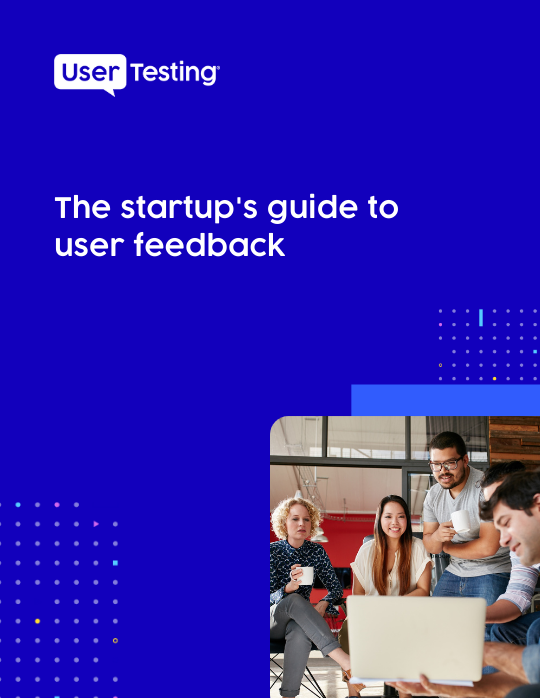How startups avoid risk and thrive with critical user testing

Launching a new startup is always a huge risk, but with effective user research and testing, product leaders can gain valuable insights from end users that help them reduce risk from the outset and build a culture of learning from their customers.
But don’t take our word for it. We recently held a virtual event and were joined by product and startup experts, including Arielle Kilroy CEO and CPO at Dado, and Justin Berkovi, CPO at Healthily, to get their top tips for ensuring success.
In this post, we’ll uncover why it’s important to:
- Validate the problem and idea before launch
- Incorporate the voice of your customer during decision making
- And embrace a culture of innovation
Validate the problem and idea before launch
Arielle Kilroy, specialises in innovation. She works with new and established companies that find themselves stuck in processes and patterns that no longer work, championing the ideas: 'testing to invalidate' and 'work to prove yourself wrong.'
While every new product is built to solve a problem, the initial idea must first be tested with the target audience. Moreover, the problem they have must be proven consistent enough to demonstrate a genuine market need and ultimately drive purchase.
Arielle said: “People love their own ideas. They love to go out on a mission to try and validate their own ideas, but really you should be trying to invalidate them. The point of experiments and testing is to say ‘what am I possibly not seeing or doing?’
“If you cannot make a concrete definition of the problem and who feels the pain of it the most, then everything that comes after will be ‘fishing’.”
Arielle recommends incorporating user testing into the ideation phase to highlight any blind spots, test theories, and learn if the target audience understands the product concept—with the overall goal to build confidence in the idea. She said: “Do incremental investments in research before you launch to help you raise your confidence level so that you can get to the next step, otherwise you're testing the most expensive way that you can possibly test.”
But what is the best way to test an idea? Arielle highlighted that product leaders can become obsessed with ‘outputs’ and getting stuff out to the world, sometimes far too early. Before anything is launched, the problem must be validated and the audience must be understood.
This can be done by sharing the idea in a digestible way, for example, hosting a mock-up landing page that explains the idea, and then following four key steps: research interviews; surveys; definition tests; and finally, reaction testing.
Validating the problem with your target audience, and getting critical feedback on the idea before launching it, will build confidence in the product and save significant time and money in the long run.
Incorporate the voice of the customer into your decision making
Justin Berkovi reiterated the importance of problem validation and launching successful tests. He suggests the imperative first step should be preparation to ensure you build an effective test, including non-biased questions and a pre-selected format, for example, moderated or unmoderated testing. This sets the team up for success and reduces the risk of bad data.
“You can never do enough preparation with research and validation. Startups have the advantage of speed, but it’s important to put in the groundwork. User testing is the perfect way to do so.”
Justin cited the critical need for human insight during both the Healthily rebrand and overall product development. Internal decision making was made simpler by turning to neutral customer bases to democratise the resolution of internal sticking points.
When testing the usability of a site, for example, qualitative research that is structured smartly means that just five responses from participants can be sufficient. As we always say at UserTesting, you don’t need 100 people to tell you that a doorknob is broken. This in-depth, emotive research allows staff to step into the shoes of the end user. It avoids any preoccupation with numbers and allows product developers to understand what audiences are loving, and what they’re not.
Justin advised: “Don’t be obsessed with data and the numbers. It’s about asking if you’re early adopters are really loving your product and you being their champion. Then the rest should follow.”
Embrace a culture of innovation
Annika Pannen, UserTesting’s solutions consultant based in Berlin, is an expert in incorporating qualitative research into small and medium-sized businesses. She emphasises the importance of a growth mindset and embracing innovation. Annika references that, of the 90% of start-ups that fail within the first five years, 42% of these didn’t have the correct market fit—and argues that effective user research and testing could have prevented this failure.
Consumers could provide negative comments on even their most favourite products, but it’s essential to uncover these sticking points in the early days to iron out as many kinks as possible and optimise the product or service. Startup leaders should take cues from Elon Musk, the infamous CEO and product architect of Tesla, who says: “Don’t tell me what you like about it. Tell me what you don’t like about it.”
In summary
Actively seeking out any product pain points or friction in the user experience can equip businesses with the knowledge they need to build an incomparable product. Over 50% of innovation stems from customers, so ignoring the opportunity to involve customer opinion will limit companies’ potential. Annika urges businesses to remember: a win for the customer is a win for the brand.
The importance of validating that a problem exists in the first place, lasering in on what your customers need, adopting a growth mindset, and prioritising user testing will drive a start-up forward with confidence, all the way from the initial idea to the first release.
Guide
Learn why fast, iterative feedback is critical to any startup's success—from concept testing to prototyping, and more.







